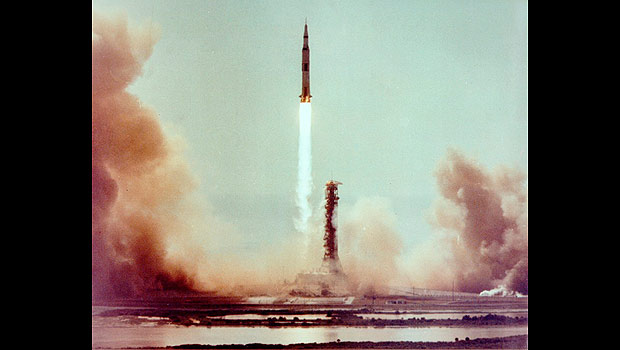The five F-1 engines were fired up on July 16, 1969, sending the massive Saturn 5 rocket on its way to the moon. The motors burned out a few minutes after liftoff from the Kennedy Space Center and tumbled into the Atlantic Ocean.
Astronauts Neil Armstrong, Buzz Aldrin and Michael Collins flew on into the history books, becoming the first humans to reach the moon.
“I was 5 years old when I watched Apollo 11 unfold on television, and without any doubt it was a big contributor to my passions for science, engineering, and exploration,” Bezos, the founder of Amazon.com and the Blue Origin rocket company, wrote in his blog on Wednesday.
“A year or so ago, I started to wonder, with the right team of undersea pros, could we find and potentially recover the F-1 engines that started mankind’s mission to the moon?” he wrote.
Using a deep-sea sonar scanner, Bezos’ team found the engines on the sea floor, some 14,000 feet (4,247 meters) below the surface.
“We’re making plans to attempt to raise one or more of them,” Bezos said.
“We don’t know yet what condition these engines might be in. They hit the ocean at high velocity and have been in salt water for more than 40 years. On the other hand, they’re made of tough stuff, so we’ll see,” he said.
NASA, which retains ownership of its space artifacts, said it was reviewing a recovery proposal it received from Bezos on Thursday.
“We’ll be working with his expedition, not necessarily out there physically, but with his team on ownership issues and what he’d like to do with them,” NASA spokesman Bob Jacobs told Reuters.
“We’ll be interested to see what condition the engines were in, how they survived the high impact on the water and after so much time sitting in the ocean,” he said.
If the salvage operation is successful, the Saturn 5 engines would be the second major piece of space history to be recovered from the sea floor.
In 1999, Discovery Channel staged an expedition to find and recover the Liberty Bell 7 capsule that was used by Mercury astronaut Virgil “Gus” Grissom on the second U.S. human space flight.
The capsule’s door blew off early and Grissom nearly drowned after his 15-minute suborbital ride. It sat on the ocean floor for 38 years until it was found and recovered by a team led by Oceaneering for a television documentary.
The capsule was refurbished by the Kansas Cosmosphere & Space Center, a Smithsonian-affiliated museum in Hutchinson, Kansas, and is now the centerpiece of an exhibit.
A spokeswoman for the Smithsonian National Air and Space Museum in Washington, the repository for NASA artifacts, said it was way too early to know whether the Apollo 11 rocket motors might someday be part of the national collection.










